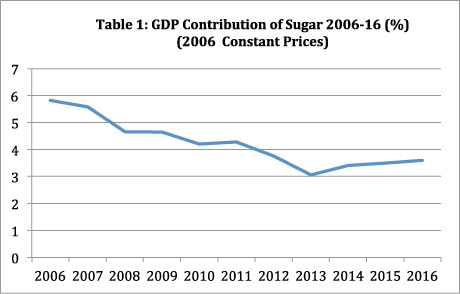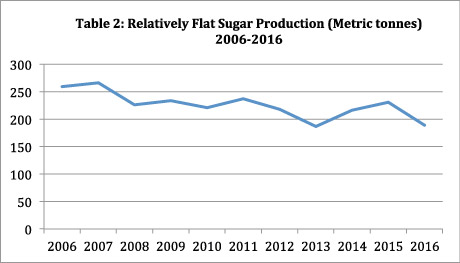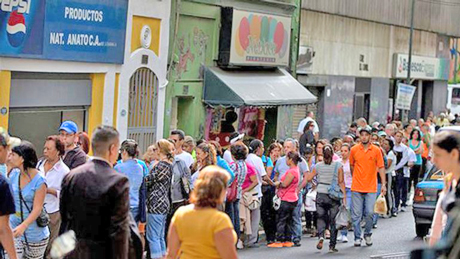Guyana Focus

(First of 2 parts)
The possibility of a Guyana without sugar – or at best with a dramatically downsized or privatized industry – is real, as the coalition APNU-AFC government ponders the closure of more estates.
But to think about Guyana without sugar, the bitter-sweet industry that has dominated the country’s political and economic landscape for close to a century is to think about the future of the people whose lives depend on the industry that was once the mainstay of the economy.
And to think that the industry is now on its deathbed – not solely because of a 36% cut in preferential tariffs by the European Union (EU) as some would lead you to believe, but more so due to inept management – is to think about whether there is sufficient reason for those whose blood, sweat and tears went into sugar, to seek justice from those who have imperiled their future.


But these are not the only things to think about. You also have to consider the enormity of the social and economic implications in a Guyana without sugar.
Incidentally, the sugar industry directly and indirectly employs almost 25,000 workers who together with their families account more than 100,000 individuals or pretty close to one-fifth of the total population.
Employment in the industry supports a network of communities across the rural sugar producing belt, and also provides infrastructural support such as roads, drainage and irrigation and other social services. The closure of sugar estates would not only hurt those that are directly impacted by the loss of employment but would also hurt businesses that serve sugar workers, leading to increased poverty and a variety of social ills.
From an economic standpoint, although the relative importance of sugar to GDP growth has declined from as high as 20% of GDP in 1992 to less than 4% in 2016, (See Table 1) it remains one of the country’s largest foreign exchange earners, ranking fourth behind gold, rice and bauxite last year, with earnings of US$73.4 million.
Ironically, while the government has been looking at other avenues to increase exports, it is doubtful whether any other commodity has the potential to replace the foreign exchange earnings that would be lost from abandoning sugar in the near future. Therefore, Guyana would be plagued by a shortage of foreign currency – as it is now – that is, until oil revenues start flowing in about three years.
While the government could be banking on oil, the loss of sugar could also affect several other industries, especially the country’s booming rum industry which earned US$37 million in foreign exchange last year.
Truth be told, the sugar industry is no longer viable. It has been plagued by a plethora of problems, key among them incompetent management, volatile to declining production, and high operational costs. The industry is bankrupt but has been kept alive by government bailouts that amount to the tune of more than GYD$500 billion over the past decade.
The bitter-sweet reality of sugar is that it has never recovered from the withdrawal of preferential pricing by the European Union (EU) in 2006, which resulted in a price cut of some 36%. Prior to the cut in EU subsidies, Guyana’s sugar shipped to the EU, its largest buyer, enjoyed higher than world market prices under the African Caribbean Pacific (ACP) Convention.
Although the EU subsequently provided some US$133 million in funds to help Guyana sustain and modernize the industry, it has headed downhill ever since, primarily because of poor management that allowed the industry to deteriorate.
GUYSUCO’s 1998-2008 modernization plan which culminated in the modernized Skeldon factory was a tragic failure. Sugar production fell instead of increased, leaving the industry with a massive debt load.
An examination of historical production patterns shows that during the 1960s, sugar output averaged almost 300,000 tons per year. During the 1970-1980 period, production averaged over 306,000 per year, with a peak of 369,000 tons in 1971. However, during the 1990-2000 period, average sugar production fell to about 245,000 tons, with 1999 output of 365,000 tons being the highest.
Over the next decade, 2001-2010, average production increased to almost 270,000 tonnes annually, supported by three years, 2002-2004, of production averaging 320,000 tones. The noticeable decline in production started in 2008 and continued through the end of 2016, causing GUYSUCO to miss the opportunity to capitalize on high world market prices during the 2010-2012 period for its non-quota production. (See Table 2).
One of the key objectives of GUYSUCO’s modernization initiatives was to bring the cost of production down to about US 12.5 cents per pound by 2008. Had management come even close to achieving this target, sugar would not have been in the trouble it is today. Instead, Guyana continues to produce sugar in the range of US 34 - 35 cents per pound, while the world market price for sugar is currently around US 13 cents per pound. Therein lies the reason for the unprofitability of the industry which cannot continue operating at a loss.
Evidently, GUYSUCO’s grandiose plan failed. The heavy toll of the EU price cut and continued losses prevented upgrades to factories and caused field operations and infrastructural works to be shelved or only partially completed, preventing the industry from striving for viability.
Today, the sugar industry is indebted to the tune of some $80 billion. Instead of looking at how the industry can be saved, the government is looking to either substantially reduce its size, abandon sugar altogether or privatize it through an outright sale. But the stark reality is that Guyana faces a future without sugar and the dire consequences that come with it.

This was disclosed by Guyana’s Ambassador to Venezuela, Ms Cheryl Miles during an update on Guyana-Venezuela relations at the conclusion of a heads of missions conference held recently at the Pegasus Hotel.
In a televised interview with the Ministry of Foreign Affairs, Miles explained that since her posting to Venezuela, much of her work has been in relation to the Guyanese Diaspora which number about 250,000 in the neighbouring country.
And despite the country's deterioration and social disruption, she said, many Guyanese are holding their own, but some are having second thoughts. “Many people now are thinking of returning to Guyana because of the difficulties in Venezuela,” she said.
She disclosed that while many persons are seeking guidance on how they can reintegrate into Guyanese society, in many cases, they are concerned that because their children may not have learned English in a structured way, that could be a hindrance in their being able to attend school in Guyana. “We are trying to see in what ways we can make it easier for them to reintegrate,” Miles said, adding that it is one of the tasks with which the Embassy is currently preoccupied.
The local media reported in February that scores of Venezuelans would regularly cross the border at Kumaka, in Region One (Barima-Waini) to do business. According to Kumaka residents at the time, this is what had obtained throughout 2016, as the economic situation in Venezuela took a turn for the worse.
Since then, supermarket shelves in Venezuela are reportedly chronically bare, and power shortages are so severe that government offices are forced to open only two days a week.
Add to this the collapse of the healthcare system, the spiralling crime rate, and progressively worsening inflation, and one could well imagine the state of affairs in Venezuela.
And as the New York Times had reported, with the plummeting oil price – Venezuela’s only export of note – revenues could fall by as much as 40 per cent this year.
It’s a situation that has, since earlier in the year, resulted in a number of Venezuela-based Guyanese relocating to the place they once called home within communities in the North West District. Kumaka residents told the local media that many persons who had relocated to Venezuela during the 1980s have since returned to the North West in search of greener pastures.
“They come across with fuel and plastic containers and clothes, and take back sugar, rice and even things like toilet paper,” a Kumaka vendor said of those Venezuelans coming there to trade items that are difficult to source in their homeland, the media report stated.
At the Kumaka Waterfront, several stalls would line the edges of the roadway close to the Aruka River, a sight that was almost non-existent prior to the collapse of the Venezuelan economy.
The area was once a matter of concern in the past, as water from the meandering Aruka River had almost eroded that section of the waterfront in recent years. However, revetment works were undertaken in the area and it has since stood the test of time. Consumer items that do exceedingly well at Kumaka include fuel, such as gasoline, which retails at approximately G$17,000 per barrel. The price reportedly dropped significantly a month ago when the authorities clamped down on the trade of fuel at Morawhanna. At the time, the price per barrel had risen to approximately $28,000.
Last December, Commissioner General of the Guyana Revenue Authority, Mr Godfrey Statia, spoke on the issue of fuel-smuggling in the area. “We also know there is fuel-smuggling in the Essequibo, in Morawhanna; we also plan to put a presence at Morawhanna,” Statia was quoted as telling the media at the time.
At the remote villages outside Mabaruma, persons would trade mainly food items with Venezuelans across the Amacuro River. The goods are usually bought at Kumaka and ferried to the border location, a practice which is not expected to end anytime soon.
Guyana and Venezuela are still to resolve a decades-old border controversy currently being managed by the United Nations.
As Ambassador Miles pointed out regarding the controversy, Georgetown maintains the firm position that the matter should go to the international court.
She drew reference to the recent visit of the UN General-Secretary’s personal representative, Ambassador Dag Nylander who was in Guyana to help the two countries find a solution to the problem by the end of the year.
If this does not happen, then recommendations will be given by the UN on how the controversy should be handled, with referral of the matter to the International Court of Justice being the likely outcome.
“Our sides are very far apart,” Ambassador Miles said. “We would like to see the issue go to the International Court of Justice; it is our firm position, and Venezuela doesn’t want that. They prefer a different form of settlement.”
Minister Trotman said that the 2017 budget has set the target of 694,000 ounces of gold, but the ministry is aiming for 700,000 ounces.
Last year’s unprecedented declaration earned the country USD$730,915,229. The country recorded the highest gold declaration with 641,668 ounces, 16.6 percent above its target. Small and medium-scale miners accounted for 429,188 ounces while Guyana Goldfields and Troy Resources, large gold mining operations, contributed 145,236 ounces and 67,244 ounces respectively.
The Guyana Gold Board recorded 451,490 ounces of gold in 2015, surpassing the 380,000 ounces target. (GINA)
According to a release, CEO of Sterling Products Limited, Ramsay Ali, was re-elected first vice-president; Yonette Jeffers of Laparkan Freight Forwarders was elected second vice-president and Autamaram Lakeram of NAMILCO retained the finance portfolio of third vice-president.
Nokta, in accepting the board’s confidence, indicated that his main objective over the year will be to consolidate and expand the organisation by strengthening relationship between the board and member companies.
He indicated that an important area of focus will be facilitating the resolution of issues affecting members through closer collaboration with key stakeholders.

“We have to produce our commodities more cheaply, otherwise we will not be able to compete, whoever is in the Government. We will not be able to compete if your commodities are too expensive. We want to save the sugar industry, but it must be efficient and competitive,” President Granger told the opening of the West Berbice Trade Fair and Exposition held at Bath Settlement.
“And Mr Sacoor (Imran Sacoor) is right. We are not working to destroy the industry, we are working to develop the industry and the industry has been contracting. Some countries like Trinidad and Tobago, Barbados, St. Kitts and Nevis, Jamaica, Belize have seen their industries contract. Some have disappeared altogether because the cost of production was too high,” President Granger said.
He added that Guyana is trying to preserve its industry. “That is why there will be a Blairmont and that is why there is going to be an Albion and we will preserve as many of our plantations and estates as possible. Uitvlugt will remain, but we have to deal with the problems of cost. So ladies and gentlemen I agree with the slogan chosen for this fair and exposition; that we must think about diversification.”
Government is expected to present a White Paper in the National Assembly soon, pertaining to the future of GuySuCo, the Cabinet Secretary announced back in March. The issue was discussed extensively at the ministerial conference held on February 28, at State House, when Minister of Agriculture, Noel Holder, made his presentation. The conclusion of consultations among government, the unions and the opposition on GuySuCo’s future, along with the options advanced by the government and the proposal made by the Guyana Agricultural and General Workers Union (GAWU), will form the basis of the White Paper, Harmon had told a news briefing.
When asked if any sugar estates will be closed, Harmon had said that proposals were made to that effect, along with diversification of several estates. He however emphasised that the welfare of sugar workers and their families is the top priority of the APNU+AFC government. “The welfare of the workers and their families is of primary concern. The other economic concerns and so on will of course be dealt with, but the workers’ interest is at the forefront of whatever policy we’re going to embrace with respect to the sugar industry,” Harmon said.
The White Paper is expected to deal with the Commission of Inquiry (CoI) into the sugar industry, the proposals by GuySuCo, the consultations held with stakeholders and GAWU’s presentation, the decisions facing government relating to the recovery of drainage and irrigation charges of the National Drainage and Irrigation Authority, diversification of the Skeldon factory and the leased lands.
In a report which was presented to the Parliamentary Economic Services Committee in January by GuySuCo’s Chairman, Clive Thomas and Chief Executive Officer (CEO), Errol Hanoman, it stated that the outlook for Guyana’s sugar industry continues to be grim as the officials declared that funds injected into sugar industry at this time will be funds “wasted.”
The industry has received criticisms from all levels with a debt of $77.3B and consecutive losses; officials are advising that the industry is one not worth investing in unless plans for the reorganisation, restructuring and diversification of the industry are present. Figures based on 2015 audited accounts, show that GuySuCo recorded a profit once in the past six years, which was recorded in 2013 due to the tax adjustment. Thus, “radical reorganisation, contraction of sugar and major diversification are urgently required for better predictability and planning,” stated the report.
The corporation’s performance deteriorated after having invested its own funds in the SSMP project (2005 onwards) which did not yield returns as expected, causing cash flow difficulties, coupled with declining sugar prices and increased costs, particularly employment costs, affecting capital and maintenance projects required to sustain and improve production levels.
The report stated that there needs to be validation of GuySuCo’s head office/central services; with the proposed plan of retaining only three estates, Albion, Blairmont and Uitvlugt. It was suggested that GuySuCo’s agriculture research centre be delinked and merged with the national research centre being developed with IDB funding.
And, the corporation’s training centre be developed as an independent technical school. But, according to the report, in order to rationalise the sugar industry from seven estates, it requires specialist expertise, because the sugar industry lacks skills and experience. The report indicated that GuySuCo’s state of affairs must not remain the same, because time is of the essence and decisions need to be made, as $18B would be required in 2017 and a further $21B in 2018, to run GuySuCo.
The embarrassing episode started last week Tuesday, when the constable saw the phone, which belonged to a TSU driver, in the barrack-room. He then stashed the device in his crotch before joining his colleagues on the drill square.
Unfortunately, the rank who had lost his phone borrowed a colleague’s device and dialed the number, while passing by the drill square.
Ranks on the drill square were reportedly shocked when the phone began to vibrate and ring in the culprit’s crotch. The device was quickly recovered and the culprit placed in custody.
On being questioned, the constable allegedly claimed that someone had hidden the phone in his crotch.
Kaieteur News reports that relatives of the detained rank have offered the victim a financial settlement. However, the constable is likely to be dismissed and placed before the court.
Recently, over 500 books, a television, a DVD player and a projector were donated to the school by the alumni organisation, called the Tagore Philanthropic Society (TPS), according to Chairman of the School Board Charlie Amar.
Amar told the media that the books came as both a Christmas gift for the students and as a form of encouragement to spur them on into becoming “prolific readers.”
Amar also noted that TPS thought it necessary for the school to have an “audio visual centre” and as a result the liaisons for TPS in Guyana, Amar Chand and his wife Jenny Chand, donated a 42-inch television system and a DVD player, while TPS donated a projector with a surround sound system to make it a reality.
In addition to those donations, Amar said that TPS has continuously invested in textbooks for the school, along with supplying equipment for the home economics department, complete basketball, volleyball and tablet tennis sets, chalk boards and educational DVDs.
According to Amar, TPS was formed in 2008, after past students thought it was a good idea to form an organisation to raise funds in an effort to give back and further improve the school they once attended. “To date, they have done tremendous help to this institution,” he said. “…Four of our students have benefited from complete scholarships at UG [University of Guyana] and they all have secured their Bachelor’s Degree, several others have completed two years of diploma courses at UG’s Tain Campus,” he noted too, while pointing out that TSP has also given financial rewards to students who topped their classes and also to the best “all round student.” They have also provided funding for after-school programmes and Saturday programmes for “slow learners,” he added.
TPS has also assisted in rebuilding the fence of the school’s playground, which was knocked out by a freak storm. Amar explained that the project cost some $1M, of which the school board paid $117,000 towards labour.



To advertise in ICW call
Call 905-738-5005